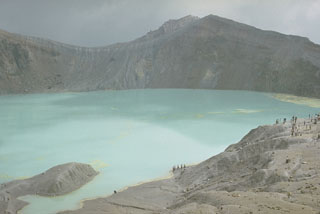Report on Kusatsu-Shiranesan (Japan) — February 1990
Bulletin of the Global Volcanism Network, vol. 15, no. 2 (February 1990)
Managing Editor: Lindsay McClelland.
Kusatsu-Shiranesan (Japan) Highest amplitude tremor since 1982-83 activity, but no eruption
Please cite this report as:
Global Volcanism Program, 1990. Report on Kusatsu-Shiranesan (Japan) (McClelland, L., ed.). Bulletin of the Global Volcanism Network, 15:2. Smithsonian Institution. https://doi.org/10.5479/si.GVP.BGVN199002-283120
Kusatsu-Shiranesan
Japan
36.618°N, 138.528°E; summit elev. 2165 m
All times are local (unless otherwise noted)
Volcanic tremor began at about 1445 on 27 January and continued through 1 February. The largest amplitude was about 0.2 µm. A field survey on 2 February found no new ash deposition around the crater. Water discoloration in Yugama crater lake was observed as usual.
Volcanic tremor resumed at 0019 on 12 February and continued until 0417 the next day. Additional tremor episodes occurred on 18 and 24 February. Amplitudes of 1.3 µm on 18 January and 1.1 µm on 24 February were the highest recorded since the last eruption in 1982-83. The number of discrete volcanic earthquakes also increased between 17 February and 7 March.
Geological Summary. The Kusatsu-Shiranesan complex, located immediately north of Asama volcano, consists of a series of overlapping pyroclastic cones and three crater lakes. The andesitic-to-dacitic volcano was formed in three eruptive stages beginning in the early to mid-Pleistocene. The Pleistocene Oshi pyroclastic flow produced extensive welded tuffs and non-welded pumice that covers much of the E, S, and SW flanks. The latest eruptive stage began about 14,000 years ago. Historical eruptions have consisted of phreatic explosions from the acidic crater lakes or their margins. Fumaroles and hot springs that dot the flanks have strongly acidified many rivers draining from the volcano. The crater was the site of active sulfur mining for many years during the 19th and 20th centuries.
Information Contacts: JMA

